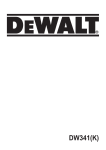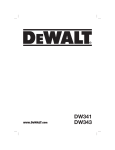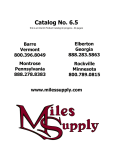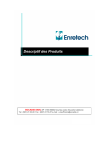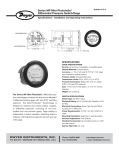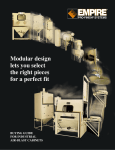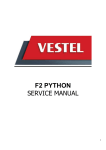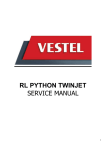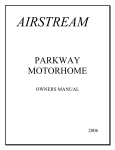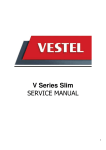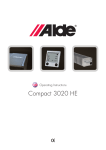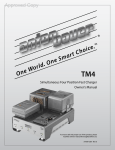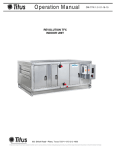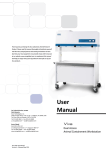Download ProFormer™ Operating Manual
Transcript
• • • • • • • • • • • • • • • • • • • • • • • • • • • • • • • • • Operating Instructions for the ProFormerTM Cabinet System Pressure and Suction 2101 West Cabot Boulevard Langhorne, PA 19047-1893 www.empire-airblast.com • • • • • • • • • • • • • • • • • • • • • • • • • • • • • • • • • Empire Abrasive Equipment Company Model Number: _______________________ Serial Number: ____________________________ Date of Purchase: ____________________ Date of Installation: _______________________ Distributor Purchased From: Name: __________________________________________________________ Address: ________________________________________________________ Phone: _________________________________________________________ * * * * * Manufactured by: EMPIRE ABRASIVE EQUIPMENT COMPANY 2101 West Cabot Boulevard Langhorne, PA 19047-1893 Phone: 215-752-8800, Fax: 215-752-9373 Empire equipment should be properly maintained per the operating instructions. For peak performance of your equipment, use only genuine Empire replacement parts; accept no substitutes! The use of non-Empire parts will void the warranty. PARTS AND SERVICE 1-800-497-4543 To order Empire replacement parts, contact your local authorized Empire distributor. For the name of your local distributor, call Empire Customer Service, 1-800-497-4543, or fax us at 215-752-9373, or e-mail us on our website www.empire-airblast.com and we will call you back. CAUTION Never use silica-based abrasives in Empire blast systems. Page 2 Empire Abrasive Equipment Company Operating Instructions for the ProFormerTM Cabinet System Suction and Pressure Empire Abrasive Equipment Company 10/06/06 Page 3 Empire Abrasive Equipment Company Table of Contents Table of Contents..................................................................................................... 4 Introduction............................................................................................................. 5 1.0 Installation ........................................................................................................ 6 1.1 Hand Tools Required ........................................................................................ 6 1.2 Preparing for Installation .................................................................................. 6 1.3 Getting Started................................................................................................. 6 1.4 Positioning the ProFormerTM System ................................................................. 6 1.5 Electrical Connections ...................................................................................... 7 1.6 Compressed Air Connection............................................................................ 10 1.7 Earth Ground................................................................................................. 11 1.8 Installation Check .......................................................................................... 11 2.0 Equipment Operation ...................................................................................... 12 2.1 Loading Media ................................................................................................ 12 2.2 Start Up ......................................................................................................... 13 2.3 Blasting ......................................................................................................... 13 2.4 Dust Collector Cartridge Cleaning................................................................... 14 2.5 Equipment Shut Down ................................................................................... 14 3.0 Equipment Adjustments.................................................................................. 15 3.1 Suction System Media Flow Adjustment ......................................................... 15 3.2 Pressure System Media Flow Adjustment........................................................ 15 3.3 Reclaimer Adjustment .................................................................................... 16 4.0 Suggestions for Efficient Blasting................................................................... 19 4.1 Media Selection and Use................................................................................. 19 4.2 Blast Pattern .................................................................................................. 20 4.3 Changing the Media ....................................................................................... 21 4.4 Pneumatic Controls ........................................................................................ 22 4.5 Helpful Hints for More Efficient Blasting ......................................................... 27 4.6 Cartridge Dust Collector Model SEM-2............................................................ 27 5.0 Maintenance .................................................................................................... 28 5.1 Daily Maintenance.......................................................................................... 28 5.2 Weekly Maintenance....................................................................................... 29 5.3 Storage or Temporary Non-Use ....................................................................... 30 6.0 Troubleshooting............................................................................................... 32 6.1 Troubleshooting Chart.................................................................................... 32 6.2 Troubleshooting the Pneumatic Control Circuit............................................... 35 7.0 Recommended Spare Parts.............................................................................. 38 8.0 Options and Accessories.................................................................................. 39 9.0 ProFormerTM Parts ........................................................................................... 41 9.1 Reclaimer ....................................................................................................... 41 9.2 Pressure Blast Systems .................................................................................. 42 9.3 Suction Blast Systems.................................................................................... 48 9.4 Dust Collector ................................................................................................ 50 9.5 Blowers (Fan & Motor) .................................................................................... 51 9.6 Ducting/Hoses ............................................................................................... 52 9.7 Pipe Strings.................................................................................................... 53 9.8 Basic Cabinet Assembly ................................................................................. 54 10.0 Warranty ........................................................................................................ 56 Page 4 Empire Abrasive Equipment Company Introduction Congratulations on your selection of the ProFormer™ Cabinet System from Empire Abrasive Equipment Company. This manual is provided to assist you with the unpacking, assembly, use, and maintenance of your ProFormer™ Cabinet System. Please read this manual carefully and keep it in the handy plastic pouch attached to your system for future reference. If you have any questions about the operation or maintenance of your equipment, contact your Empire distributor. Empire: The leader in air-blast technology. Empire specializes in the design and manufacture of air-blast equipment, and has continued as an industry leader of more than 50 years. Today, Empire produces the most extensive line of air-blast products in the world. In addition to ProFormer™ systems, our product line includes Pro-Finish® Cabinets, ECON-O-FINISH™ Cabinets, Modified Systems, Automated Blast Systems, Blast Rooms, and SuperBlast™ Portable Blasters. Empire Abrasive Equipment Company’s reputation as a leader in air-blast technology is the result of meeting our customer’s demand for quality equipment and systems that deliver increased productivity. We support our equipment with training, service, and testing programs. When you need advice, assistance, or equipment on short notice, our national network of distributors assures that help is nearby. Figure 1. ProFormerTM Cabinet System Page 5 Empire Abrasive Equipment Company 1.0 Installation 1.1 Hand Tools Required The following tools are recommended for the mechanical installation of your ProFormer™ Cabinet system: • 6” adjustable wrench • 9/16” wrench or socket • 14” Pipe wrenches • Channel Lock Pliers • medium Phillips head screwdriver • medium flat-blade screwdriver 1.2 Preparing for Installation Your ProFormer™ system is fully assembled. Compressed air, earth ground, and electric power are all that need to be connected. The equipment must be placed on a level surface. Do not install your ProFormer™ system on a floor subject to wet conditions. 1.3 Getting Started Step 1: Unwrap and remove the cabinet from the pallet. Step 2: Using the built-in forklift channels at the bottom of the cabinet, move the system to the installation location. Step 3: Insure there is adequate space on both sides of the cabinet for full opening of part loading/unloading and maintenance access doors. PF3642 cabinets require 37 inches and PF 4652 cabinets require 44 inches on each side of the cabinet. 1.4 Positioning the ProFormerTM System Step 1: Place the cabinet and stabilize it by adjusting the leveling bolts to compensate for any unevenness in the floor. Step 2: Insure that there is adequate space at both sides of the system for easy access to components such as the reclaimer on the left hand side and the dust drum and dust collector on the right hand side. There must be adequate space for work pieces to be easily loaded and unloaded through the cabinet doors. Step 3: Leave a space of 6 to 8 inches behind the cabinet for the compressed air supply line. There is a 2 ½ inch hole provided on the bottom right side of the system back wall for air supply line access. Page 6 Empire Abrasive Equipment Company 1.5 Electrical Connections IMPORTANT All electrical connections to the ProFormerTM cabinet should be made by a qualified electrician and must adhere to the codes, standards, and procedures specified by the authority having jurisdiction. The customer is responsible for providing appropriate disconnecting means adjacent to the equipment for each incoming power circuit. The standard power supply for the ProFormer™ 600 CFM, 1 ½ HP system is 220240volts/60 cycle/single phase. Cabinets are also available pre-wired for the optional power supplies listed in section 8.0 Options and Accessories. The standard 220-240 volt single-phase system is supplied with a 10 foot, 4-wire line cord which is connected to the cabinet light box. See Figure 3. Canadian CSA approved single-phase cabinets have no line cord. Electrical connections are made in the cabinet light box. See Figures 3. All three-phase systems have no line cord. Electrical connections are made in the transformer/contactor electrical box. See Figure 1. If your system is a three-phase power supply, wire the system as shown in Figure 5. Use the adjacent tables for the approximate current draw in amps for the voltage of your system. SINGLE-PHASE SINGLE SOURCE SOURCE MOTOR CURRENT 110-120V/60HZ 1 ½ HP 23.0 A 220-240V/60HZ 1 ½ HP 13.0 A 220-240V/50HZ 1 ½ HP 15.0 A THREE-PHASE SINGLE SOURCE SOURCE MOTOR CURRENT 208V/60HZ 1 ½ HP 9.3 A 220-240V/60HZ 1 ½ HP 8.1 A 440-480V/60HZ 1 ½ HP 4.0 A 550-600V/60HZ 1 ½ HP 3.2 A 380V/50HZ 1 ½ HP 3.9 A THREE-PHASE & SINGLE-PHASE DUAL SOURCE SOURCE MOTOR CURRENT * 208V/60HZ 1 ½ HP 6.9 A 220-240V/60HZ 1 ½ HP 6.0 A 440-480V/60HZ 1 ½ HP 3.0 A 550-600V/60HZ 1 ½ HP 2.4 A 380V/50HZ 1 ½ HP 2.6 A • The approximate single-phase current draw for all dual source systems is 3 amps at 110-120 VAC. Page 7 Empire Abrasive Equipment Company Figure 2. Electrical Connection Locations The three-phase schematic shown in Figure 5 also appears on the back of the transformer/contactor electrical box cover. The 10 foot, 4-wire line cord is located above the cabinet light box. The single-phase schematic shown in Figure 4 also appears on the back of the light box cover. Figure 3. Single-Phase Terminal Board Access For Canadian CSA approved single-phase cabinets, remove the four screws from the cabinet light box cover. Move the cover to the side and pull the attached terminal board plate from the light box as shown in Figure 3. Page 8 Empire Abrasive Equipment Company IMPORTANT Before connecting power, check that the voltage requirements of your ProFormer system are consistent with the voltage available at the installation site. Figure 4. 220-240 Volt Single-Phase Figure 5. Three-Phase Option Note: The transformer is not included with dual-source systems. Page 9 Empire Abrasive Equipment Company 1.6 Compressed Air Connection IMPORTANT To operate properly, your ProFormerTM system requires clean, dry air. Moisture or oil in the compressed air supply can contaminate the abrasive, which can prevent it from flowing freely and cause inefficient blasting. Though your system is equipped with a general-purpose filter to remove small amounts of condensed water and oil from compressed air supply, this filter is not designed to clean grossly contaminated air. Step 1: Using the following two charts, determine the proper air volume needed for your ProFormer™ system. Step 2: The volume of air required for efficient operation of your system depends on the size of the nozzle you are using and the desired blast pressure. The chart lists the minimum air requirements in SCFM for various nozzles and pressures. AIR REQUIREMENTS (SCFM) FOR SUCTION BLAST 40 psi 60 psi 80 psi ¼” nozzle, 1/8” air jet 12 17 21 5/16” nozzle*, 5/32” air jet 19 27 34 3/8” nozzle, 3/16” air jet 29 39 50 7/16” nozzle, 7/32” air jet 38 52 66 AIR REQUIREMENTS (SCFM) FOR PRESSURE BLAST 40 psi 60 psi 80 psi 1/8” nozzle 10 14 17 3/16” nozzle* 22 30 38 ¼” nozzle† 41 54 68 * Standard nozzle † 3/4” blast hose option is recommended to reduce blast hose wear. 100 psi 26 42 62 80 100 psi 20 45 81 Step 3: Use the chart below as a guide to determine the size of the compressed air line needed for your ProFormer™ system. Even when there is sufficient compressed air available, the supply air line to the system must be large enough to prevent friction losses that create pressure drops which will reduce blast pressure and efficiency. Step 4: The customer is to provide and install an air supply shut off valve. This should be a three-way valve that will bleed off all trapped down stream compressed air from the cabinet. The valve must also be able to be locked when closed. Line Size (in) ¾ 1 1-1/4 Length of Air Line (ft) Up to 95 95 to 190 190 to 350 Page 10 Air Volume (SCFM) 13 to 38 38 to 59 59 to 85 Empire Abrasive Equipment Company 1.7 Earth Ground An Earth Ground stud is provided at the bottom right side on the enclosure back wall. It is important to connect the ProFormer™ system to an Earth Ground to bleed off static electricity which may be generated while blasting. The Earth Ground may also reduce the discomfort an operator may experience when static electricity is discharged. The Earth Ground conductors may be insulated or bare. Note that defects are more easily detected during visual inspections of bare conductors. The minimum wire size is dictated by mechanical strength rather than current carrying capacity. Flexible conductors should be used when frequent connecting and disconnecting of the Earth Ground is anticipated. 1.8 Installation Check Step 1: Check that all pipe and hose connections are tightly fastened and air tight. Check that all safety pins are properly installed in all quick couplings. Step 2: Check that all electrical box covers are securely installed. Turn on the plant compressed air supply to the system. Step 3: Check that the dust drum under the dust collector has been installed properly. It must be sitting squarely on the dust drum platform and centered under the cover. Set the dust collector pulse pressure regulator to 40 psi. Check that the optional fan silencer is fully opened. Step 4: Turn the cabinet snap switch to the On position. The cabinet lights will illuminate and the dust collector fan will start. Check that the fan is rotating in the correct direction. CAUTION Disable and lock out power sources before performing service or maintenance work. Do not look into the fan outlet to determine the correct motor rotation. Check that the fan exhaust is clear of tools and free of debris before checking fan rotation. To avoid personal injury, stay clear of the fan exhaust. Step 5: Set the blast air pressure regulator to the desired pressure. The blast pressure may be set as low as 20 psi, but do not exceed 125 psi. Step 6: Insert both hands into the cabinet gloves and firmly grasp the suction gun or pressure nozzle. Step on the foot treadle. The blast should start. After a few seconds, the airflow from the nozzle will stabilize. Blast will stop when the foot treadle is released. Step 7: If applicable, press each dust collector pulse button once with the dust collector on to insure pulse function. The optional Photohelic control pulsing of the dust collector filters is automatic. Adjust both red needles to below zero psi. The black needle must rise above both red needles to activate the pulse. An increase in the gauge zero adjustment may be required to test this function. After a successful test, the gauge setpoints should be Page 11 Empire Abrasive Equipment Company set at a value of 2 psi for minimum, and 4 psi for the maximum pressure. When the system is off, reset this gauge to zero. Step 8: Turn the cabinet snap switch to the Off position. The cabinet lights will extinguish and the dust collector fan will stop. The ProFormer™ system is now ready for media loading and part processing. 2.0 Equipment Operation 2.1 Loading Media There are two methods for loading media into the ProFormer™ system. Always check the media level in the system before adding additional media. See section 4.1 for Media Selection and Use. The suction system hopper should be filled to the bottom of the reclaimer screen. The pressure system vessel may be filled to the base of the sealing plunger. Total media capacity by weight for the suction and pressure ProFormer™ system is shown for popular media in the table below. Method 1: With the cabinet switch OFF, media may be loaded through the removable reclaimer access door. The reclaimer is located inside the left component access door. After loading the media, reinstall the reclaimer door and insure an airtight seal. Method 2: With the snap switch ON and the dust collector running, load media through the media load station inside the right cabinet door. Place the appropriate quantity of media between the cabinet cone and media load station baffle. The system will slowly add the new media. Suction Pressure Glass Beads Aluminum Oxide Steel Shot or Grit 10 lb. 75 lb. 15 lb. 100 lb. 25 lb. 200 lb. Walnut Shells or Plastic 5 lb. 30 lb. IMPORTANT Be careful not to overfill pressure systems. Overfilling will cause malfunction and premature wear. See section 5.1 Daily Maintenance. CAUTION If your application requires aggressive media, such as aluminum oxide, garnet, or steel grit, it is recommended that you use optional heavy-duty ducting, reclaimer lining, and DI-CARB or BORON nozzles to prevent premature wear. Empire strongly recommends using boron carbide nozzles when blasting with Aluminum oxide, which is the most abrasive media. If these options are not included with your system, they can be added. Optional Rubber curtains for interior cabinet surfaces are also available. Consult your Empire distributor for details. Page 12 Empire Abrasive Equipment Company 2.2 Start Up Step 1: Check that all pipe and hose connections are tightly fastened and air tight. Check that all safety pins are properly installed in all quick couplings. Step 2: Perform maintenance checks per section 5.0 Maintenance. Step 3: Check that the dust drum under the dust collector is empty and has been installed properly. It must be sitting squarely on the dust drum platform and centered under the cover. The dust drum and cover must create an air tight seal. Step 4: Turn on the plant compressed air supply. Turn the cabinet snap switch to the On position. The cabinet lights will illuminate and the dust collector fan will start. Step 5: Place the parts to be blast treated inside the blast cabinet. The parts must be free of oil, grease, and moisture. Close and latch the cabinet load doors. Step 6: Set the blast air pressure regulator to the desired pressure. Recommended blast pressure ranges for various media types are listed in the table in section 4.1 Media Selection and Use. Do not exceed 125 psi blast pressure. 2.3 Blasting Step 1: Insert each hand into a cabinet glove and grip the suction gun or pressure nozzle assembly firmly. Aim the nozzle at the part to be blast treated. Step 2: Step on the foot treadle to start the blast. After a few seconds the abrasive flow will stabilize and you will be ready for blasting. Step 3: Do not pump the foot treadle. It will decrease blast efficiency and cause premature wear of system components. Step 4: Hold the gun or nozzle at a 90-degree angle to the part at a distance that produces the fastest results. This distance may vary from 3 to 18 inches, depending on the work piece and the desired finish. See section 4.2 Blast Pattern. Step 5: During the blasting process, periodically check the Minihelic pressure gauge located above and to the right of the cabinet window. This gauge indicates the condition of the filters. If the gauge pressure is 4 psi or greater, clean the filters as outlined in section 2.4 Dust Collector Cartridge Cleaning. Step 6: The reclaimer screen will require periodic cleaning. The frequency of cleaning will depend on the volume of debris produced. Step 7: For pressure systems, all the media in the pressure vessel will be used up after an extended period of blasting. The operator must release the foot treadle to stop the blast and depressurize the vessel. After a wait of approximately 2 minutes, media will fill the pressure vessel and blasting can resume. Step 8: When blasting of the part is complete, blast additional parts or follow the instructions in section 2.5 Equipment Shut Down to shut the system down. Page 13 Empire Abrasive Equipment Company 2.4 Dust Collector Cartridge Cleaning IMPORTANT Never pulse clean the filters when the system is off. If dust is visible exiting the dust collector fan housing, stop blasting and service the collector. Pushbutton Control: During the blasting process, periodically check the Minihelic pressure gauge located above and to the right of the cabinet window. This gauge indicates the condition of the filters. If the gauge pressure is 4 psi or greater, the filters must be cleaned. Press and release one pushbutton which will clean one of the cartridges. Wait 10 seconds. Press and release the other pushbutton which will clean the other cartridge. Continue this process alternating pushbuttons until the pressure is reduced to 2 psi. Photohelic Control Option: This option pulse cleans the dust collector filters automatically when they need cleaning. The gauge high limit red needle must be set at 4 psi as the maximum operating limit. The gauge low limit red needle must be set at 2 psi as the minimum operating limit. The pulse pressure must be set at 40 psi. IMPORTANT Always use proper safety and protective equipment when disposing of collector waste. Dispose of this waste properly. WARNINGS Explosive Dust: Explosive dust is generated from blast media, removed coatings and substrates. An extreme concentration of dust may combust if ignited by spark or flame. As a precaution, clean the system and empty the dust collector often. Change media that has excessive dust concentration. Emptying the Dust Collector: Always wear an appropriate dust mask when emptying the dust collector and changing filters. Empty the dust collector daily. 2.5 Equipment Shut Down Step 1: Release the foot treadle. The blast will stop. Remove the blast treated parts from the blast cabinet. Step 2: Check the Minihelic pressure gauge for the condition of the duct collector filters. If the gauge pressure is 4 psi or greater, the filters must be cleaned. Press and release one pushbutton which will clean one of the cartridges. Wait 10 seconds. Press and release the other pushbutton which will clean the other cartridge. Continue this process alternating pushbuttons until the pressure is reduced to 2 psi. Step 3: Turn the cabinet snap switch to the Off position. Empty the dust collector waste drum. Replace the drum squarely on the dust drum platform and centered under the cover. The dust drum and cover must create an air tight seal. Page 14 Empire Abrasive Equipment Company 3.0 Equipment Adjustments 3.1 Suction System Media Flow Adjustment The ProFormer™ suction blast system is equipped with the SAR-2 media regulator to control the flow of media to the suction blast gun. The regulator is located at the bottom of the storage hopper assembly inside the left component access door. The amount of media entering the hose is controlled by how far the media hose is inserted into the regulator. For normal operation, approximately ½ of the air inlet port is blocked by the media hose. This may vary slightly when changing media size nozzle size, and/or blast pressure. To find a uniform media flow, loosen the thumbscrew and slide the media hose into the SAR-2 regulator to increase and withdraw the hose to decrease media flow at the nozzle. To determine if media is flowing, look through the media regulator air inlet while the gun is operating. Listen for the sound of the blast to be smooth and constant. 3.2 Pressure System Media Flow Adjustment The ProFormer™ pressure blast system is supplied with the patented Sure-Flo® Media Regulator which is installed at the bottom discharge port of the pressure vessel. By rotating the T-handle, media flow through the regulator and out of the blast nozzle may be adjusted. Step 1: Rotate the T-handle counter-clockwise until there is no resistance. Reverse direction and make three full turns of the handle. Step 2: As the T-handle is turned clockwise, the media flow through the regulator will be reduced. While the system is blasting, make final adjustments in ½ turn, ¼ turn, or 1/8 turn increments. IMPORTANT Optimum and most efficient blast is when the media exiting the blast nozzle is just visible. Sure-Flo® Media Regulator adjustment may vary slightly when media size, nozzle size, and/or blast pressure is changed. There are occasions when blast pressure, media, and nozzle size requirements will not allow the SureFlo® Media Regulator to be properly adjusted to the desired media flow rate. Refer to the tag attached to the regulator T-handle for additional instructions and see section 4.0 Suggestions for Efficient Blasting for helpful hints. Page 15 Empire Abrasive Equipment Company 3.3 Reclaimer Adjustment All ProFormer™ reclaimers can be adjusted to control the average size of media retained by the reclaimer. The reclaimer is supplied with a “tune-able” secondary air adjustment. When the band is properly adjusted reusable media will be returned to the media storage hopper. Unwanted dust and broken down media (fines) will be removed from the system and conveyed to the dust collector. See Figure 6. Empire’s reclaimer design has vertical slots with a solid tuning band. The original ProFormer™ reclaimers have horizontal slots in both the reclaimer and tuning band. Fine tuning adjustments of both reclaimers are similar. Just remember to move the band in the direction of the reclaimer slots; horizontal slots rotate the band, vertical slots slide band up or down. The tuning band is joined at both ends by a bolt and wing nut that must be loosened before the band can be adjusted. The slot pattern around the reclaimer body has one slot omitted. The joined ends of the tuning band must be located over the area of the omitted slot. NOTE Dust collectors require a coating of dust on the filter cartridges to achieve maximum filter efficiency, also known as “seasoning”. The filters are seasoned when the static pressure reading on the collector gauge is 2 or greater. Step 1: Start with no reclaimer slots visible. Adjust the band in one direction until 1/16” of opening is created between the band and reclaimer slots. HELPFUL HINT Place a reference pencil mark on reclaimer body (and a corresponding reference mark on the tuning band if horizontal slots). Step 2: Operate the blast system for at least one hour. Step 3: Turn the cabinet snap switch to OFF. Step 4: Inspect the dust collector waste drum for reusable media. Step 5: If no media is found in the waste, adjust the tuning band to expose 1/16” more reclaimer body slot area. Step 6: Make a new reference mark on the reclaimer body. Step 7: Repeat Steps 2 through 7 until a small amount of media is found in the dust collector waste. Adjustment is complete. Page 16 Empire Abrasive Equipment Company NOTE As a new system is used, the filters become coated with dust, “seasoned” and the airflow in the recovery system will decease to the normal operating rate. This will affect previous reclaimer tuning band adjustments. If visibility becomes poor inside the cabinet when blasting, there is too much dust mixed with the blast media. The reclaimer tuning band should be re-adjusted. Follow Step 2 though 7. NOTE For systems with large quantities of dust mixed with blast media, all dust and media should be removed from the system and new media installed. Step 8: If more than a small amount of media is found in the dust collector waste, additional reclaimer tuning band adjustment may be required. Follow Steps 9 through 13. Step 9: Adjust the tuning band back to the previous reference mark on the reclaimer body, reducing the opening between the reclaimer and the band. Step 10: After operating the blast system for at least one (1) hour, turn the cabinet power switch OFF. Inspect the dust drum waste for reusable media. Step 11: If no media is found in the waste, adjust the tuning band to expose 1/16” less reclaimer body slot area. Step 12: Make a new reference mark on the reclaimer body. Step 13: Repeat Steps 8 through 13 until a small amount of media is found in the dust collector waste. Adjustment is complete. The schematic diagrams in Figure 6 illustrate: (1) the basic operation of the system. (2) the air and media flow before and after blasting. Page 17 Empire Abrasive Equipment Company Figure 6. Blast and Recovery Operation IMPORTANT An insufficient volume of secondary air entering the reclaimer will cause dust to accumulate with the “good” media in the storage hopper or pressure vessel. This accumulation leads to inefficient blasting. Conversely, too much secondary air will cause useful media to be carried to the dust collector and be wasted. To avoid these conditions, adjust the tuning band to meet your specific blasting requirements. When your system is new, it will be necessary to readjust the tuning band periodically until the filters are “seasoned”. Page 18 Empire Abrasive Equipment Company 4.0 Suggestions for Efficient Blasting 4.1 Media Selection and Use Proper media selection strongly influences the efficiency of your blasting operation. Your choice of media depends on the kind of job to be done (cleaning, deburring, smoothing sharp edges, paint removal, preparation for coatings, etc.) The size of the media depends on the results you need. Fine media results in more impacts per second over a given area. Therefore, fine media is preferred for easy blasting jobs, such as the removal of light rust from steel. Large media results in fewer impacts, but each impact has more force, so that large media is more suitable for difficult jobs, such as removal of mill scale. Sometimes large and find media may be combined for optimum results. The chart below lists the range of media recommended for each ProFormer™ Blast System. Certain media, such as sand and slag, are not to be used in ProFormer™ cabinets, both for health reasons and because they pulverize on impact and cannot be recirculated. Media Type Aluminum Oxide or Garnet Glass Beads Steel Grit Steel Shot Walnut Shells or Plastic Any Size Media Size 46 to 80 Mesh 100 to 300 Mesh 25 to 180 Mesh 200 to 300 Mesh G-16 to G-50 G-80 to G-200 S-390 to S-170 S-110 to S-70 Suction R R* R R* NR R NR R R* Pressure R R** R R** NR R NR R R** R – Recommended. * Recommended optional vibrating screen for mesh sizes 200 to 300 or when high humidity is a problem. NR – Not Recommended. ** Recommended optional vibrating screen and aerated media regulator for mesh sizes 200 to 300. Spherical media, such as glass beads, are used for general purpose cleaning and finishing where a satin-like finish is desired with little dimensional change. Glass beads are effective when used with pressures in the 20 to 60 PSI range. Above 60 PSI, excessive bead breakdown will occur. Angular aggressive media, such as aluminum oxide, steel grit, and garnet generally provide faster cleaning and produce a less-polished finish compared to glass beads. Aluminum oxide and steel grit are suitable for use at pressures up to 100 PSI. Garnet breaks down quickly at pressures greater than 40 PSI. Walnut shells or plastic are sometimes used for delicate parts, paint removal, or when a polished finish is required. Pressures from 20 to 100 PSI may be used with these media, depending on the application. When changing from one type of media to another, clean the cabinet interior and media hoses thoroughly to avoid cross contamination. Page 19 Empire Abrasive Equipment Company CAUTION If your application requires aggressive media, such as aluminum oxide, garnet, or steel grit, it is recommended that you use optional heavy duty ducting, reclaimer lining, and DI-CARB or BORON nozzles to prevent premature wear. Empire strongly recommends using boron carbide nozzles when blasting with Aluminum oxide, which is the most abrasive media. If these options are not included with your system, they can be added. Optional Rubber curtains for interior cabinet surfaces are also available. Consult your Empire distributor for details. 4.2 Blast Pattern The size of the effective blasting pattern varies with the size, type and length of the nozzle, blast air pressure, and the nature of the work piece. Use the following chart and diagram as a guide, but be aware that the approximate pattern diameters can only be determined by considering each case individually. Figure 7. Blast Pattern Suction Blast Pressure Blast Blast Pattern Diameter at Distance Listed Nozzle ID A B ¼ ¾ 1¼ 5/16 1 1½ 7/16 1 1/8 1¾ 1/8 ¾ 1¼ 3/16 1 1½ ¼ 1 1/8 1¾ Suction Blast at a distance of greater than 12” is usually not effective. Page 20 C * * * 2¼ 2 3/8 2 1/2 Empire Abrasive Equipment Company 4.3 Changing the Media When changing from one type or size of media to another, it can be extremely important to clean out the blast and recovery hoses, storage hopper, pressure vessel, and the cabinet interior thoroughly to avoid contamination of the new media. IMPORTANT Always use proper safety and protective equipment when disposing of collector waste. Dispose of this waste properly. Suction System Step 1: Turn the ProFormer™ system off. Open the left side equipment access door and locate the reclaimer, media storage hopper, and SAR-2 media regulator. Step 2: Using proper safety and protective equipment, place a container, such as a bucket, directly under the storage hopper and SAR-2 regulator. Loosen (do not remove) the 7/16” nut at the bottom of the regulator plug. Pull down on the plug removing it from the regulator. This will allow the media to empty from the storage hopper into the container. Step 3: Turn the ProFormer™ system on. Close and latch the part loading doors. Insert each hand into a cabinet glove and grip the suction gun firmly. Aim the nozzle toward the back of the blast cabinet and press the foot treadle. Blast for 30 seconds to remove all media from the suction hose and gun assembly. Step 4: Release the foot treadle. Using proper safety and protective equipment, open one of the part loading doors and use the Blowoff gun to remove the media from ledges and surfaces into the cone for recovery. Step 5: Turn the ProFormer™ system off. Clean both reclaimer screens, reinstall the SAR-2 drain plug, and close the reclaimer door. Dispose of all waste properly. Step 6: The system is ready for new media. Refer to section 2.1 Loading Media, section 3.1 Suction System Media Flow Adjustment, and section 3.3 Reclaimer Adjustment. Pressure System Step 1: Turn the ProFormer™ system off. Open the left side equipment access door and locate the reclaimer, media storage hopper, and pressure vessel. Step 2: Adjust the T-handle of the Sure-Flo® grit valve counter clockwise, fully opening the regulator. Close the 1” ball valve (choke valve) located on the pressure vessel pipe string assembly. Fully open the reclaimer tuning band. Step 3: Turn the ProFormer™ system on and open a part loading door. Remove the pressure nozzle and nozzle washer from the end of the blast hose. Place a container, such as a bucket, inside the blast cabinet. Place the blast hose inside the container and close and latch the part loading doors. Page 21 Empire Abrasive Equipment Company Step 4: Adjust the blast pressure regulator to 40 psi. Insert each hand into a cabinet glove and grip the blast hose firmly. Aim the hose into the container and press the foot treadle. Blast for 30 seconds to remove all media from the blast hose. Step 5: Turn the ProFormer™ system off. Clean both reclaimer screens, readjust the Sure-Flo® grit valve, and close the reclaimer door. Dispose of all waste properly. Step 6: The system is ready for new media. Refer to section 2.1 Loading Media, section 3.2 Pressure system Media Flow Adjustment, and section 3.3 Reclaimer Adjustment. 4.4 Pneumatic Controls The ProFormer™ system uses a patented pneumatic control circuit to protect workers, workers environment, and activate the blast. Step 1: Turning the system snap switch on energizes the interlock solenoid valve, permits air to enter the control air line to the foot treadle, illuminates cabinet lights and start the fan motor. Step 2: The operator steps on the foot treadle opening a three way control air valve. Air enters the door interlock supply tubing continuing to the door air jets. If the part load/unload doors are closed, latched, and door air jets are sealed, the control air lines pressurize and open the main blast air valve (and the pressure systems exhaust valve to close). The opening of the main air valve starts the blast. Step 3: When the operator removes his foot from the foot treadle, the three way air valve close, shutting off air to the controls, and exhausting all down stream air. The control air line pressure bleeds from the door interlock supply tubing, main blast air valve (and the pressure system exhaust valve). This permits the main blast air valve to close (and the pressure system exhaust valve to open) stopping the blast. Step 4: When a part load/unload door is opened, the pad covering the door interlock air jet is unseated. When the foot treadle is pressed with a door open, control air bleeds from the door air jet opening, preventing the control circuit from pressurizing. The main blast air valve will not open, and blasting will not occur. Page 22 Empire Abrasive Equipment Company The following schematic diagrams illustrate the pneumatic control circuits for suction systems (Figure 8A) and pressure systems (Figures 8B). For each system type, the cabinets are shown in blasting and non-blasting modes (shaded pipe is pressurized). Figure 8A. Page 23 Empire Abrasive Equipment Company Figure 8B. Page 24 Empire Abrasive Equipment Company The following drawings show media flow through a typical pressure system and are provided to help you understand how to maintain the media at the proper level. Pictured at right is a fully charged system with the vessel depressurized (no blasting). Note that the media fills the pressure vessel but that there is not media in the storage hopper. Figure 9. Before Blasting When blasting starts, the vessel pressurizes, the media impacts the part being blasted, and reusable media is recovered and accumulates in the storage hopper. Continuous blasting time is limited by the type and amount of abrasive in the in the vessel when blasting starts (normally 8 to 15 minutes with a fully charged 1 cubic foot vessel, depending on nozzle size and blast air pressure). Each time the operator stops blasting, the vessel de-pressurizes and the sealing plunger drops. Media in the storage hopper flows into the vessel. If blasting is stopped long enough (usually 1-2 minutes), all media in the storage hopper will transfer into the pressure vessel. Figure 10. During Blasting Page 25 Empire Abrasive Equipment Company Thus, you can determine the amount of media in the vessel in either of two ways: (1) note how much continuous blast time you can achieve with a fully charged vessel and compare this with your current continuous blast time; or (2) stop blasting, open the reclaimer door, and visually determine the media level by looking into the top of the vessel. Figure 11. After Blasting Overfilling pressure vessels will cause improper operation and premature wear. Allow sufficient time after blasting for the pressure vessel to refill (2 minutes). When the pressure vessel is filled, check to see if any media has remained in the storage hopper, indicating that the vessel is overfilled, the sealing plunger may not seat tightly when you start blasting. See section 5.3 Storage or Temporary Non-Use for instructions on how to empty the pressure vessel. Refer to section 2.1 Loading Media for instructions to add media. Figure 12. Pressure Vessel Overfilled Page 26 Empire Abrasive Equipment Company 4.5 Helpful Hints for More Efficient Blasting The efficiency of your blasting operation depends on four factors: 1) 2) 3) 4) Equipment selection Media selection Operating procedures Maintenance With the help of your Empire Distributor and/or Empire factory representative, you now own equipment that will properly meet your blasting requirements. You can select the proper media, operating procedures, and maintenance steps by following the recommendations in this manual. If you need more information about any aspect of your machine’s operation or the blasting process, contact your local distributor or the factory. The following measures will also help you improve the efficiency of your blasting operation: Step 1: To accomplish more in less time, use the largest nozzle practical for your operation. Of course, nozzle diameter may be limited by the amount of compressed air available, but an increased volume of compressed air is often justified by reduced labor costs. Also, if you are blasting small parts, it doesn’t make sense to use a big nozzle, as most of the blast pattern will be overspray. Step 2: For faster cleaning, use the highest pressure practical for your operation. Maximum pressure for a given operation is limited by type of media (e.g. glass beads can break down rapidly above a certain pressure) and amount of material which must be removed from the workpiece. Step 3: If you are blasting small parts, it may be more efficient to manipulate the part with tow hands and use an optional fixed nozzle holder. Step 4: Never underestimate the importance of clean, dry air. More operational problems are traceable to the lack of clean dry air than any other single factor. If the supply air is not clean and dry, media quickly becomes contaminated, causing flow problems, which wastes media and leads to excessive operator downtime. 4.6 Cartridge Dust Collector Model SEM-2 ™ Additional information about the operation of the ProFormer Cartridge Dust Collector can be found in the collector Installation and Operation Manual. This manual can be found inside the left maintenance access door in an envelope attached to the inside left rear wall of the system. Page 27 Empire Abrasive Equipment Company 5.0 Maintenance 5.1 Daily Maintenance Step 1: Turn the cabinet snap switch on. Step 2: Remove the accumulated dust from the dust collector drum and the debris from the reclaimer screen. Step 3: Check the condition of the media. If the media is contaminated or broken down into dust, thoroughly clean the inside of the cabinet and recovery system and reload with new media. See section 2.1 Loading Media. Step 4: Adjust the reclaimer tuning band if you observe a dusty condition when blasting. See section 3.3 Reclaimer Adjustment. Step 5: Check the media level. For optimal operation, the media level should not drop below one-half the recommended capacity. A. The media level in suction systems can be observed in the media storage hopper. B. The media level in pressure systems can be observed by looking through the optional sight glasses or the reclaimer door down into the top of the vessel. When the vessel is de-pressurized, the sealing plunger must be visible. Add media until just visible below the sealing plunger. Step 6: Check light bulbs and gloves. Replace as required. Step 7: Open the manual drain on the general-purpose filter in the cabinet pipe string and drain any accumulated moisture and oil. Close the drain and dispose of the waste properly. Step 8: All quick coupling connections must be equipped with safety pins. Inspect all couplings and blast hoses daily for splits, bubbles, soft spots, etc. Screws should be flush with coupling surfaces. Tighten screws, if necessary. Page 28 Empire Abrasive Equipment Company 5.2 Weekly Maintenance CAUTION If your application requires aggressive media, such as aluminum oxide, garnet, or steel grit, it is recommended that you use optional heavy duty ducting, reclaimer lining, and DI-CARB or BORON nozzles to prevent premature wear. Empire strongly recommends using boron carbide nozzles when blasting with Aluminum oxide, which is the most abrasive media. If these options are not included with your system, they can be added. Optional Rubber curtains for interior cabinet surfaces are also available. Consult your Empire distributor for details. Step 1: Repeat the daily maintenance procedures. Step 2: Inspect all media-carrying hoses for wear by feeling along the length of the hose for soft spots. Hoses with soft spots should be replaced. Step 3: Check the nozzle for wear. When the nozzle is worn 1/8” oversize, replace it. A drill bit can be inserted into the nozzle to check its size. Step 4: On suction systems, check the air jet for wear. Step 5: Loosen the set screw in the side of the gun body and remove the air jet. See Figure 13. Figure 13. Air Jet Step 6: If the air jet shows wear, rotate it 90° and reinsert it into the gun. Step 7: Re-tighten the set screw. IMPORTANT If an air jet is allowed to wear completely through, it will cause premature wear of the gun body and nozzle. Step 8: Check the nozzle adapter and gun body for wear. Replace if necessary. Step 9: Check the window gaskets for leaks. Replace if necessary. Page 29 Empire Abrasive Equipment Company Step 10: Check your spare parts inventory. Ensure that you have an adequate supply of replacement items. 5.3 Storage or Temporary Non-Use If your ProFormer™ system will not be used for several days (or more), follow these steps to remove media and prevent media from caking inside the system: Step 1: • Suction systems: Empty media from the cabinet and storage hopper. To remove the media from the storage hopper: remove the rubber plug from the bottom of the SAR-2 regulator. • For pressure systems: A) Reduce blast pressure to 40 PSI. B) Close the choke (ball) valve on the pressure vessel pipe string. (See Figure 14). Figure 14. Closed Choke Valve Remove the blast nozzle and washer from the blast hose. C) Pressurize the vessel as if to blast. These steps will cause the media to flow from the open end of the blast hose in a controlled manner. The media can now be directed into a suitable container or receptacle. After the pressure vessel is empty: D) Open the choke valve. Page 30 Empire Abrasive Equipment Company E) Replace the nozzle washer and nozzle. F) Return the blast pressure setting to normal. Step 2: Drain the general purpose filter. Close the drain valve. Page 31 Empire Abrasive Equipment Company 6.0 Troubleshooting 6.1 Troubleshooting Chart Problem: Good media is being carried to the dust collector. Probable Cause Remedy New filters. Continue use until filter “cake” forms (approximately eight hours of operation). Tuning band is open too Adjust tuning band. far. Insufficient media in Add media to recommended media suction hopper allows level. secondary air to enter. Media too fine. Use more coarse media. Pressure systems: Worn Replace plunger and/or sealing ring. plunger or sealing ring leaking air into reclaimer. Problem: Media is escaping into the work area from the dust collector. Probable Cause Remedy Hole in dust filter(s)or Replace leaking filter(s)or refasten loose filter(s). filter(s). Problem: Poor visibility during blasting. Probable Cause Reclaimer not adjusted properly. Clogged dust bag(s). “Blinded” filters (reduced air flow due to age of the filters). Fan rotation backwards. Media has high dust content. Recovery hose blocked. Cabinet air inlet plugged. Dust collector door leaks air. Blast nozzle or air jet too large. Operating air pressure too high. Page 32 Remedy Adjust reclaimer air inlet settings See section 3.0 Equipment Adjustments. Shake dust bag or dust collector bags. Over a period of years dust may penetrate the dust filter to the extent that normal air flow is restricted even when filters are pulsed regularly. When this condition is reached, replace the filters. Reverse the fan rotation. Replace media and adjust reclaimer tuning band. Remove hose, inspect and remove obstruction. Blow filter clean with air line. Tighten door, replace gasket if necessary. Replace worn nozzle with recommended size: maximum ¼” diameter pressure, maximum 7/32” air jet for suction. Decrease pressure to within recommended range. Empire Abrasive Equipment Company Problem: No air or media flow from the nozzle. Probable Cause Compressed air line shut off. Cabinet Doors not tightly closed. Regulator adjusted to zero. Nozzle clogged. Door interlock air hose leaking. Problem: Poor production rate. Probable Cause Low blast air pressure. Nozzle too small (the smaller the nozzle, the smaller the blast pattern). Improper media. Improper media flow. Low media level. Parts to be blasted are oily or wet. Media has high dust content (Blast media breaks down and must be replaced on a regular basis). Remedy Open all air valves from compressor. Close cabinet doors sealing door interlock. Adjust regulator. Disassemble and clean nozzle. Replace hose. If problem continues, see section 6.2 Troubleshooting the Pneumatic Control Circuit. Remedy Increase pressure within the specified range. Install a larger nozzle (and air jet on suction systems) to accommodate your production needs. See section 4.1 Media Selection and Use. See section 3.0 Equipment Adjustments. Add media to maintain recommended level. Parts to be processed must be absolutely dry and free of oil, grease, etc. Remove old media from system and replace with new. Adjust reclaimer tuning band. See section 3.3 Equipment Adjustments. Problem: Static charge build-up and discharge irritates the operator. Probable Cause Remedy Low quality blast hose Replace blast hose with one of high (poor conductor of static quality. Static charges are created charge). and build up by the air and media moving at high velocity through the blast hose. System grounded Earth ground the system. improperly. Part insulated, resting on Place part on metal surface, i.e. rubber mat. cabinet floor or turntable top. Low compressed air and Install Empire Anti Static Strap, part ambient humidity. 510411. Problem: There is blast air flow, but intermittent or no media flow. Probable Cause Remedy Blast air pressure too low. Adjust and maintain pressure within recommended range. Clogged nozzle. Disassemble and clean nozzle. Page 33 Empire Abrasive Equipment Company Damp media (If media stays formed in a ball after squeezed in the palm of the hand, it is too damp to flow properly). Suction System: Improper air jet nozzle combination. Suction System: Media hose improperly installed. Suction System: Clogged media hose. Pressure System: Sure-Flo media regulator closed. Pressure System: Leaking sealing plunger and/or exhaust valve. Pressure System: Sure-Flo media regulator obstructed. Page 34 Remove damp media from system and replace with new, dry media. Check compressed air supply filters. Do not blast wet or oily parts. Nozzle orifice size must be twice the air jet orifice size 1/8”diameter air jet requires minimum ¼” diameter nozzle. Adjust media hose in media regulator. Check media hose at entry to the suction gun body, hose clamp nut, oring, and hose must create an air tight seal. Remove media hose from media regulator at the bottom to the media storage hopper, bring that end of the hose through an open door and into the cabinet. Remove the nozzle from the suction gun, insert the blow-off gun nozzle in the open end of the media hose, and blow accumulated media and/or debris out through the suction gun. Adjust media regulator. Check for compressed air leaks and repair. Open Sure-Flo media regulator to full open, close the choke valve, remove blast nozzle, set blast pressure at 7080 PSIG and attempt to blast. All air will be forced through the media regulator clearing the obstruction. If media flow problems persist, shut off and lock out compressed air supply, disassemble media regulator and clear obstruction. Empire Abrasive Equipment Company 6.2 Troubleshooting the Pneumatic Control Circuit Hand Tools Required: The following tools are required to troubleshoot the pneumatic control circuit: • • • Pressure tester (P/N 140382) 7/16” open end wrench Flat-blade screwdriver Step-by-Step Procedures: Refer to the control circuits shown in Figures 15 and 16 and the troubleshooting procedures listed on the pages that follow. Figure 15. Pneumatic Circuit – Suction Figure 16. Pneumatic Circuit - Pressure Page 35 Empire Abrasive Equipment Company Problem: Switch is on. The lights and dust collector motor work, but blast will not activate. Probable Cause Test Remedy Step 1: Confirm that the If there is no air from the dust off The compressed air compressed air is on by gun, turn the air supply to the system supply to the activating the dust off gun on. system is off. inside the blast cabinet. If there is air from the dust off gun, go to Step 2. Step 2: Observe the blast pressure If there is no pressure, replace the The blast pressure gauge. If the gauge is at gauge and or regulator. regulator is set to zero, adjust the handle If the gauge shows that there is zero. clockwise until the pressure and still no blast, go to Step pressure is greater than 3. 20 psi. Step 3: With the system on, open If there is no air, go to Step 4. Failed interlock a cabinet door and step on If there is air, go to Step 5. solenoid or foot the foot treadle. High treadle valve. pressure air should exit the door interlock air jet. Step 4: Turn the snap switch off If no air exits the hose, the interlock Failed foot treadle and disconnect the air solenoid or snap switch is defective. valve. supply hose on the left Replace the switch before replacing side of the foot treadle. the valve. Hold the loose hose end If air exits the hose, the foot treadle away from personnel, and valve has failed. Repair or replace the switch the system on. valve. High pressure air should exit the hose. Step 5: With both cabinet doors If leaking, the cabinet access door The door air jets closed, step on the foot must be closed tightly so that the air are leaking. treadle. Listen and feel for jets are sealed air tight. air leaking at each door Check and replace worn or damaged interlock air jet. urethane bumpers in the doors. If the door interlock air jets are sealed with no leaks, go to Step 6. Step 6: Disconnect the control If the gauge is reading the line The control tubing tubing at the pipe string (supply) pressure, go to Step 7. is leaking. air valve. Install a If the gauge reading is not the line pressure gauge on the (supply) pressure, go to Step 8. open end of the tubing and step on the foot treadle. The gauge should indicate the line (supply) pressure to the system. Step 7: Reconnect the control If the gauge is reading below the line The blast air valve tubing at the pipe string (supply) pressure, the blast air valve is defective. air valve. Install a diaphragm has failed. Repair or pressure gauge on the replace the air valve. control line and step on the foot treadle. Observe the gauge pressure. Page 36 Empire Abrasive Equipment Company Step 8: There are media problems. Check the vent in the blast air valve diaphragm cover spring retainer nut for leaking air. Improper media. Improper media flow. Confirms that the blast air valve diaphragm has failed. Repair or replace the air valve. See section 4.1 Media Selection and Use. See section 3.0 Equipment Adjustment. Problem: There is excessive delay between stepping on the foot treadle and the blast activation. Normally this delay should be between ½ and 1 second for suction systems and 1 to 2 seconds for pressure systems. Probable Cause Test Remedy Step 1: Disconnect the control Check for kinks or crimps in the Restricted flow in tubing at the pipe string control air lines. control lines. air valve. Install a pressure gauge on the open end of the tubing and step on the foot treadle. The gauge slowly reaches the full line (supply) pressure. Step 2: Disconnect the control Trace leaks by moving the gauge up Leak in control stream until the full line pressure is tubing at the pipe string lines. air valve. Install a observed. pressure gauge on the For pressure systems only, if the open end of the tubing gauge at the exhaust valve and step on the foot pressurizes rapidly to full line treadle. The gauge never pressure, the exhaust valve has a leak reaches the full line or a ruptured diaphragm. (supply) pressure. Page 37 Empire Abrasive Equipment Company 7.0 Recommended Spare Parts The following chart lists the parts you should maintain in inventory to ensure continuous operation of your ProFormer™ system. Qty Part No. 501331 Description ¼” Di-carb nozzle (suction) or 1 501341 5/16” Di-carb nozzle (suction) or 501351 501272 7/16” Di-carb nozzle (suction) 1/8” Di-carb nozzle (pressure) or 1 501282 3/16” Di-carb nozzle (pressure) or 2 20’ 1 25’ 10 501292 532701 524441 290182 520792 524802 10 520802 10 1 2 pair 1 1 1 2 1 1 524101 518661 509891 524451 510401 519001 523523 523942 510431 522351 ¼” Di-carb nozzle (pressure) Floodlights Door gasket Exhaust valve ½” blast hose 5/8” blast hose NW-5 nozzle washer for ceramic nozzles QC washer Foot treadle valve Rubber gloves Window gasket Window safety glass Interlock solenoid Filter Sealing ring Plunger, for 1 cu. ft. pressure vessel 4 x 8 return hose or 516103 753551 505651 6 x 3 Recovery hose MH-2 Gun Body 3/32” air jet or 505661 1/8” air jet or 505671 5/32” air jet or 505691 520822 520252 523592 7/32” air jet Exhaust hose Tubing fittings Sure-Flo metering tube ¾” 1 1 Pressure X X X X X X X X X X X X X X X X X X X X X X X X X X X X X 2 6’ 2 1 Suction Page 38 X X X Empire Abrasive Equipment Company 8.0 Options and Accessories A variety of standard accessories are available for any ProFormer™ system. These accessories can be either factory installed or customer installed with a minimum of cabinet modification. Category 1. Optional Electricals Options 220-240/50/1 208/60/3 220-240/60/3 380/50/3 440-480/60/3 550-600/60/3 2. Turntables - Stationary or Tracks 3. Fine-Tuning Controls 4. Fine-Tuning with Choke 5. Fixed-Orifice Media Regulator 6. Low Media-Level Sensor and Indicator (Factory Installed Option) 7. Harsh Media and Extended Wear Components Reclaimer urethane coating Reclaimer UltraWear lining Di-Carb® (tungsten carbide) nozzles Boron carbide Nozzles Rubber curtains Window protectors Matting 8. Fixed Gun (or Nozzle) Holder If your production requirements change, you can add the options you need to update your system. Description Voltage/Frequency/Phase of power available. Available with Manual, turntables facilitate the handling of heavy parts. The turntable dolly travels on a track, or is fixed inside the cabinet. Most stationary designs feature a low profile that provides operators with easy “over-the-top” access and does not waste interior cabinet space. Turntable size 24” diameter with standard capacities ranging from 300 to 1000 pounds. Pressure blast systems incorporating Empire’s automatic Sure-Flo media regulator, allow the operator to adjust the richness of the air-to-media mixture from the workstation at the front of the cabinet. As a result, dialing in the optimum air-to-media ratio for a particular job is greatly simplified. To further assist the operator, an indicator gauge displays relative media richness. In applications where media is changed frequently, or where contamination can cause periodic clogging of the media regulator, a push-button choke is available with fine tuning. In applications such as shot peening, in which very precise metering of media is required, a fixed-orifice media regulator is attached below the Sure-Flo media regulator. The low media-level sensor and indicator warns the operator when the media supply in the pressure vessel is low. The indicator/sensor consists of an electronic probe in the vessel that activates a signal light mounted on the front of the cabinet. Empire’s extended wear components increase service life in an aggressive or high-use environment. These components are normally very cost-effective because they reduce downtime, repair interval, and maintenance costs. Extended wear components are sold individually so you can tailor features to your application needs and budget The urethane coating extends the service life of interior wear surfaces by five times. The Ultra-Wear lining increases normal service life by a factor of ten. Di-Carb nozzles are for use with steel abrasives and glass beads. Boron carbide nozzles are for use with aluminum oxide, silicon carbide, and garnet media. Cabinet life is increased with the use of rubber curtains. Freehanging curtains are made of black 1/8” neoprene and held in place with rubber knobs for easy replacement. These curtains actually last longer than steel. White curtains are available to brighten the cabinet interior, and it doesn’t degrade with use, as does white paint on steel. Window protectors can be provided in clear plastic or as a perforated screen to reduce frosting and pitting of the cabinet window. To pad parts and prolong the life of steel support surfaces, mats are offered for turntable tops and cabinet floors. Suction blast systems The fixed gun holder is adjustable to position any gun in any orientation so the operator can use both hands to manipulate work pieces in the blast stream. Pressure blast systems The fixed nozzle holder, which bolts anywhere on the cabinet wall, can be adjusted to position the nozzle in any orientation, leaving Page 39 Empire Abrasive Equipment Company Category 9. Fine Media Kits Options Vibrating screen and (for pressure systems only) aerated media regulator 10. Magnetic Reclaim Separator 11. Dust Collector Option NOTE: For more information about options, contact your Empire distributor or the factory. Photohelic Controlled pulse jet cleaning Description both of the operator’s hands free to manipulate work pieces. A vibrating screen in the reclaimer (plus an aerated media regulator for pressure systems) overcome flow problems associated with very find abrasives (200 to 300 mesh range), lightweight blast media (plastics, walnut shells, etc.), and high humidity. Magnetic reclaim separator reduces possible damage to delicate substrates by removing steel and other ferrous contaminants from the blast media as it passes through the reclaimer. The separator consists of an industrial magnet that can be removed through the reclaimer door for cleaning. Automatically pulse the filters as required. Page 40 Empire Abrasive Equipment Company 9.0 ProFormerTM Parts 9.1 Reclaimer Item 1 2 3 4 5 6 7 8 9 10 11 12 13 14 15 16 17 18 600 CFM 140796 766741 770788 524321 524371 524342 767581 551782 552392 509581 544122 551842 552542 522762 739041 739051 760711 520822 520181 520512 Description Reclaimer Body Assembly Removable top Door, reclaimer Gasket, reclaimer door Gasket, reclaimer to storage hopper Gasket, tuning band Tuning Band (steel part only) Bolt, 1/4"-20 x 2" Wing nut, 1/4"-20 Latch and keeper (requires welding) Plug, 1" NPT (Suction systems only) Bolt, 3/8"-16 x 1" (8 required) Nut, 3/8"-16 (1 gun suction systems), 8 required Lock Washer 3/8 Screen, fine, 11-1/2" OD 8 Mesh Screen, coarse, 11-1/2" OD 4 Mesh Screen, flat, 5/16", 13" OD Blast Hose, 1”, 5’ long Hose Barb, 1” Hose Clamp, 2” Page 41 Empire Abrasive Equipment Company 9.2 Pressure Blast Systems Parts for Blast Hose Assembly – Standard 1/2” Item 1 2 3 4 5 6 Part Number 504912 505232 524041 524052 505222 505782 524101 525102 7 523931 8 554242 9 10 11 510511 564822 520792 Model Number NA-2 NC-1/2 NW-5 NW-2 QC-1/2 UF-100 AHCW AHCW (1" x 13/8") (#8 x 3/8") PBH-1/2 Description Nozzle Adapter Nozzle Coupling Nozzle Washer, Ceramic nozzles, 5/8" ID (10 pack) Nozzle Washer, Di-Carb/Boron, 1/2" ID (10 pack) Quick Coupling with washer + screw package item 4, 5, 6 Tank Coupling, 1" FPT with AHCW Coupling Washer (10 pack) Coupling Washer (25 pack) Grommet, blast hose Screws (4 pack) Safety pin Tag, safety, screw/coupling Blast Hose (Maximum length: 50') Page 42 Empire Abrasive Equipment Company Blast & Air Hoses 3642 Only 140302 — (5') 4652 Only 140303 — (6') — 522541 521672 520792 — (5') — (5') Item Bulk 1 — 520912 2 Description Air hose assembly, 1" ID Air hose, 1" ID (Air hose length) Blast hose assembly, 1/2" ID (see previous chart) Blast hose, 1/2" ID (Blast hose length, std cabinet) Exhaust Hose Item 3 4 5 Part Number 522611 520822 520181 520512 Description Exhaust hose assembly (with 1" NPT barb ends), 5’ for 1 cu. ft. vessel Exhaust hose (1" ID blast hose) (Maximum length: 50') Hose barb, 1" NPT x 1" ID hose (1 each end) Hose clamp, 2" (1 each end) Pressure Vessel Item 6 7 8 9 10 11 12 13 14 15 16 17 18 19 Part Number 140802 760813 760739 524371 523942 510431 546072 545702 517503 518492 520581 520912 545822 546192 567332 567312 Description Pressure vessel assembly, 1 cu. ft. Pressure vessel only, 1 cu. ft., ProFormer Hopper, 1-cubic foot, ProFormer Gasket, reclaimer to hopper) Sealing ring, rubber, 2-1/8" ID Plunger, sealing, PVC coated Plunger guide (1/2" NPT x 3-1/2" nipple) Tee, 1" x 1” x 1/2" NPT Check valve, 1" NPT Ball valve, 1" NPT Hose clamp for 1" ID hose (1 each end) Hose, 1" ID (specify 1.5' for 1 cu. ft.; 3.5' for 3 cu. ft.) Tee, 1" x 2" x 1' NPT Nipple, 1" NPT x close, HD Label, WARNING “Do not disassemble…” Label, WARNING “Flange above…” Page 43 Empire Abrasive Equipment Company Sure-Flo Media Regulators Part Number 290383 Catalog Name Manual 290215 Automatic 290188 Conversion kit Description Manual Sure-Flo Media Regulator (grit valve) normally open, 9" clearance required Automatic Sure-Flo Media Regulator (grit valve) normally closed, 9" clearance required Converts Manual Sure-Flo to Automatic Shipping Weight 25 lbs. 30 lbs. 25 lbs. Manual Sure-Flo Media Regulator Parts Item 1 2 3 4 5 6 7 8 9 10 11 12 13 14 Part Number 525451 525782 523592 523512 525792 525802 753692 552222 753092 551352 753632 753292 552052 552762 552542 552672 551902 753372 290384 Description Nozzle Metering tube, 3/8" ID Small Metering tube, 1/2" ID Small-Med Metering tube, 3/4" ID Medium Metering tube, 3/4" ID Medium Metering tube, 5/8" ID Med-large Metering tube, 7/8" ID Large Valve body, 2" MPT Bolt, 7/16"-14 x 1-1/4" Roller stop/holder Screw, 8-32 x 1/2" (2 per assembly) Pinch roller (2 per assembly) Flange, 2" MPT Bolt, carriage, 3/8"-16 x 2-1/2" (4) Lock washer, 3/8" ID (6) Nut, hex 3/8" -16 (6) 1/2" Jam nut Bolt, hex 3/8" -16 x 3" (2) Adapter, manual body, Sure-Flo Handle assembly, 1/2" -13 x 4" Page 44 Grit Fine Fine-Med Medium Medium Med-coarse Coarse Comments Back out roller bolt 1/2" Back out roller 1/2" Supplied as standard Use below 32 F. (red) — High production use Empire Abrasive Equipment Company Automatic Sure-Flo Media Regulator Parts Item 1 2 3 4 5 6 7 8 9 10 11 12 13 14 15 16 17 18 19 20 21 22 23 24 25 26 27 28 29 30 31 32 Part Number 525451 525782 523592 523512 525792 525802 753692 552222 753092 551352 753632 753292 552052 552762 552542 552672 N/A N/A N/A 551852 552662 290217 753622 551732 505802 505822 753682 753112 521081 753462 561422 505872 552842 525002 525012 290296 565452 Description Nozzle Grit Metering tube, 3/8" ID Small Fine Metering tube, 1/2" ID Small-Med Fine-Med Metering tube, 3/4" ID Medium Medium Metering tube, 3/4" ID Medium Medium Metering tube, 5/8" ID Med-large Med-coarse Metering tube, 7/8" ID Large Coarse Valve body, 2" MPT Bolt, 7/16" - 14 x 1-1/4" Roller stop/holder Screw, 8-32 x 1/2" (2 per assembly) Pinch roller (2 per assembly) Flange, 2" MPT Bolt, carriage, 3/8"- 16 x 2-1/2" (10) Lock washer, 3/8" ID (12) Nut, hex 3/8" – 16 (8) 1/2" Jam nut (1/2"-13) (Not shown in drawing) (Not shown in drawing) (Not shown in drawing) Bolt, 3/8" – 16 x 1-1/4" (2/Auto Sure-Flo) Nut, extension 3/8" – 16 (2/Auto Sure-Flo) Handle assembly, 1/2" – 13, Automatic Sure-Flo Handle (only), 1/2" – 13 Set screw, 1/2" – 13 x 1/2", nyloc Shaft, handle Spring tensioner Spring enclosure Diaphragm cover Adapter, 1/4" NPT x 1/4" Tube) Plunger guide O-ring kit (includes 2 for guide & 1 for plunger) Plunger with O-ring Washer, 1/2" ID Gasket, diaphragm Diaphragm Spring assembly (includes item shown in Detail B) Tag, instructions, Sure-Flo Page 45 Comments Back out roller bolt 1/2" Back out roller bolt 1/2" Supplied as standard Use below 32 F. (red) — High production use Empire Abrasive Equipment Company Spring & Diaphragm Assembly Detail WARNING Never attempt to disassemble the spring assembly in the automatic Sure-Flo. The spring is under tension and could cause injury to personnel. MG-78 Exhaust Valve Assembly & Options Item Part Number 290182 290184 502081 Description Exhaust valve, MG-78 (with ceramic restrictor kit) Boron carbide upgrade for restrictor kit, extended wear, Factory Installed (option) Boron carbide upgrade replacement restrictor. Exhaust Valve Components Item Part Number 290183 1 2 3 4 5 6 7 8 9 10 11 753332 753412 524132 525322 553412 753392 753402 523672 753382 552842 551962 Description Rebuild Kit, MG-78 (Seat & gasket, ball, diaphragm, 3 screws, drawing). (items 2, 3, 4, 14) Note: MG-78 castings must be in good condition to use PN 290183 effectively. Valve body Seat, valve ball (steel) Gasket, seat Valve ball (also used on 411 & 412 valves) Spacer washer, steel (1/2" ID x 2" OD x 1/4" thick) Spacer ring, inner Spacer ring, outer Diaphragm (2 per assembly) Cover, valve Washer (1/2" ID x 2" OD x 1/16" thick) Bolt, 1/2" -13 x 1-3/4" Page 46 Empire Abrasive Equipment Company 12 553982 13 552762 14 551122 15 544512 16 520181 Restrictor Parts 290218 502431 17 502081 290184 18 552952 19 524062 20 524082 Bolt, 3/8" -16 x 2" Lock washer, 3/8" Screws, seat, 1/4" -20 x 1/2" (pack of 3) Reducer bushing, 1-1/4" MPT x 1" FPT Hose Barb 1” Ceramic Restrictor kit (standard) Ceramic nozzle (standard) Boron carbide upgrade for restrictor kit, customer installed (extended wear) Boron carbide upgrade for restrictor kit, factory installed (extended wear) Washer, steel Washer, nozzle, NW-1 (1" ID x 1-1/2" OD x 1/4" thick) (pack of 10) Washer, nozzle, NW-4 (3/4" ID x 1-1/2" OD x 1/4" thick) (pack of 10) Page 47 Empire Abrasive Equipment Company 9.3 Suction Blast Systems Components Item 1 2 3 4 5 6 Part Number 760751 546332 524371 520502 523921 523931 Description Hopper, 1 – gun suction Nipple, 1-1/4" NPT x 3" Gasket, reclaimer to hopper Hose clamp, 1/2" air hose (2 per hose) Grommet, air hose, 3/4" x 1-1/16" Grommet, blast hose, 1" x 1-3/8" Blast & Air Hoses Item 7 Bulk — 520861 8 — 520802 3642 522841 — (7') 522581 — (8') 4652 522851 — (8') 522591 — (9') Page 48 Description Air hose assembly, 1/2" ID Air hose, 1/2" ID (Air hose length, std cabinet) Blast hose section, 5/8" ID Blast hose, 5/8" ID (Blast hose length, std cabinet) Empire Abrasive Equipment Company SAR-2 Media Regulator Item 9 10 11 12 Part Number 290156 753351 510121 551042 Description SAR-2 Media Regulator, complete, 1-1/4" FPT Regulator body, SAR-2 Plug, clean out Thumb screw, 1/4"-20 x 1" PARTS for MH-2 Guns Item 1 2 3 4 5 6 7 8 9 10 11 Part Number 753551 753561 505651 505661 505671 505681 505691 505701 520402 505621 523912 526171 505641 504931 523881 520081 551702 511251 Description Gun body, MH-2 LONG handle Gun body, MH-2 SHORT handle Air jet, 3/32" (orange) Air jet, 1/8" (yellow) Air jet, 5/32" (green) Air jet, 3/16" (blue) Air jet, 7/32" (white) Air jet, 1/4" (red) Hose barb, 1/2" FPT x 1/2" hose Connector, MH-2 O-Ring, 1/2" ID x 5/8" OD (2 required) Sleeve, rubber, for air jet Nozzle adapter, plastic (standard) Nozzle adapter, steel O-Ring, 1-1/16" ID x 1-5/16" OD Nut, hose clamp, MH-2 Set screw, 1/4"-20 x 3/8" Spring, suction gun assist Page 49 Empire Abrasive Equipment Company 9.4 Dust Collector Components Item 1 2 2A 3 4 5 6 Part Number 532523 516329 516328 516104 516106 515710 515765 Description Filter Assembly, (2) Diaphragm Valve, (2) Rebuild Kit, Diaphragm Valve Hose, 7” ID x 6” long Cover Gasket, Neoprene, 9-1/2” ID x 12” OD Waste Pail Page 50 Empire Abrasive Equipment Company 9.5 Blowers (Fan & Motor) Blower Assemblies Standard CFM @ Used with Electrical 6" S.P. 140312 1-1/2 230/60/1 600 SEM-2 Note: Motor starters, contactors, interconnecting wiring and ducting not included. Part Number Horsepower Components All 1-1/2 Description Sizes 1 — 549681 Motor, 115/230V, 60 Hz, Single phase (Motor part numbers shown in BOLD are supplied as standard most often.) 2 — 753661 Impeller (fan blade), 11-1/2" dia., 5/8" ID 3 — 753511 Housing, fan, top 4 — 753521 Housing, fan, bottom 5 523251 — Gasket, fan housing, 1/8" x 1/4" (5' section) 6 — 524361 Gasket, mounting (3 required) 7 — 739011 Guard, fan outlet 8 554431 — Clip, fan guard (4 required) — 553182 Screw, flat head 3/8" -16 x 2-1/4" (dust collector) 9 — 551312 Screw, flat head 3/8"-16 x 1-1/4" (slide gate) 10 — 552072 Screw, flat head 3/8" -16 x 1 11 — — Bolt, 1/4" –20 x 3/4" 12 — — Clip, 1/4"-20 13 — — Bolt, 1/4"-20 x 1 14 — 751501 Flange 15 — 140759 Silencer (optional) Item Page 51 Notes Empire Abrasive Equipment Company 9.6 Ducting/Hoses Conveying Hose Standard Systems – Suction or Pressure with Reclaimer & Collector Part Number Item Description Customer Factory Installed Upgrade 522351 Standard Duty Conveying Hose w/o clamps — (4" x 8’) (I.D. x length) 1 140354 140338 Heavy Duty Conveying Hose w/clamps (4" x 9’) 4" x 9’ (I.D. x length) Dust Hose Item 2 3 4 Part Number 516103 (6" x 31') 526413 769917 Description Standard Dust Hose, w/o clamps (I.D. x length) 4” Urethane Elbow, 90 degrees Adapter, Ductwork, 4” Hose to 4” Urethane Clamps and Adapters Item Part Number Description 520531 Hose clamp, Standard Duty conveying hose 5 522953 Hose clamp, Heavy Duty conveying hose (4") (Nominal hose diameter) 520551 Hose clamp, dust hose 6 (6") (Nominal hose diameter) Note: (2) hose clamps are required per hose. Page 52 Empire Abrasive Equipment Company 9.7 Pipe Strings Pipe String Assemblies Part Number 140279 140280 Pipe String Size 1/2" 1" Used With Suction – 1 gun Pressure, FaStrip Pipe String Mounting Hardware Part Number 564121 552882 552522 Quantity 4 4 4 Description 1/4" flat head bolt 1/4" washer 1/4" hex nut 1/2" Pipe String 1" Pipe String Components Item Both Sizes 1/2" Only 1" Only Description 504652 517271 Air Filter (1/2" manual, 1" manual; Norgren) 1 — 508012 508002 Element for Norgren air filter, 5µ 508112 505161 O-ring and gasket kit for Norgren air filter 517141 517251 Air Pressure Regulator (Norgren) 2 — 508102 508161 Diaphragm & O-ring kit for Norgren regulator 517042 — — Main Air Valve (1" Aquamatic) 517582 — — Diaphragm and seal kit for 1" Aquamatic 3 518512 — — Special wrench for 1" Aquamatic 517583 — — Repair Kit for 1" Aquamatic* 4 — 550232 550232 Gauge, (550232 1/4" NPT; 550212 1/8" NPT back mount) 6 522155 — — Mounting Feet/Quick Clamp 7 522157 — — Porting Block 8 520222 — — Hose adapter, 1/4" x 1/4" 9 522154 — — Quick Clamp 10 522156 — — Adapter 11 — — 543542 Elbow, 1" NPT street 12 — — 505782 Coupling, 1" FPT, UF-100 13 — — 510511 Safety pin 14 523261 — — Vent 15 520432 — — Adapter 1/4" Tube x 1/4" NPT 90 16 — 544497 — Bushing, 1" x 1/2" Brass 17 — 543533 — Elbow, 1/2" x 90 18 — 520362 — Hose Barb, 1/2" * Repair kit P/N 517583 includes the seal kit P/N 517582. O-Ring for modular pipe strings P/N 522162. Page 53 Empire Abrasive Equipment Company 9.8 Basic Cabinet Assembly Components 9 10 Both Sizes 510401 524451 760291 523551 510461 551852 525931 140544 509891 510821 520561 555016 3642 Only — — — — — — — — — — — — 4652 Only — — — — — — — — — — — — 11 524441 — — 12† 13† 14 15 16 16A 17 18 19 20 21 22 23† 24* 25 26† 27 28† 29† 30 525041 521561 509371 751242 509381 300016 504201 504101 509611 — 516103 510491 532701 580191 532711 534561 533611 519001 520252 520432 — — — — — — — — — 765023 — — — — — — — — — — — — — — — — — — — 765043 — Item 1* 2† 3 4 5 6 7 8* — — — — — — — — Page 54 Description Safety Glass, 14" x 22" ∆ Gasket, window, 6' section Frame, window Gasket, window frame per ft., 6’ required Knob, 3/8" -16, (4) required Bolt, 3/8" -16 x 1-1/4", (4) required Spacer, window, (4) required Window Kit (items 1 through 6) Gloves, pair Glove, left hand Clamp, 8", per glove Glove Hole Flange, Plastic Gasket, ¾” x ¾”, 20” for 3642/24” for 4652 Bumper, urethane Interlock Hose Latch, Door, w/o Handle Hole Catch, Door Spacer, Catch, Shim Only Latch Kit, Items 14, 15 & 16 Gauge, Minihelic Manual Pushbutton, (2) required Dust Bucket, 5 Gallon Roof Cover Dust Hose, 6” Filter, Kleensweep™ inlet, (2) required Floodlight bulb Gasket, light bulb, 1 per bulb Light fixture, with gasket Switch, Snap, 20 amp Terminal strip, 10 pole Solenoid valve, Standard and CSA Barbed fitting, 1/4" tube x #10-32 Adapter, 1/4" tube x 1/8" MPT, 90˚ Empire Abrasive Equipment Company 31 32† 33 34 35 36 37 38 39 40 41 42 43 44 45 46 47 48 49 518651 518661 518671 522661 509821 523951 523931 523921 536391 — — 509531 509005 523523 760151 140802 140796 113036 140280 140279 — — — — — 522631 — — — — — — — — 522641 — — — 760697 551742 — — — — — — — — — 760698 551742 — — — — — — — — — 50 140312 — — 51 52 53 54 567391 564305 564301 523533 — — — — — — — — * † †† ** Foot Treadle Assembly Valve, for Foot Treadle Repair Kit, For Treadle Valve Hose Assembly, ¼”, for Foot Treadle Gun, dust off Hose with fittings, dust off gun Grommet, dust off hose 1/4"-5/8" x 7/8" Grommet, blast hose, 1"x 1-3/8" Grommet, suction air hose, 3/4" x 1-1/16" Hole Seal Floor section, std cabinet, (2) required Leveling bolt, 3/8" -16 x 2", (4) required Hinge, 3", (10) required Latch, Compression, (4) required Filter, SEM-2, (2) required Z-strip, reclaimer mount Pressure Vessel Assembly, Reclaimer Assembly Dust Collector Assembly, SEM-2 Piping Assembly, 1” Piping Assembly, ½” Blower Assembly, 1-1/2 HP, 230V/60Hz/1-Ph Decal, Instruction/Warnings Decal, Empire logo Decal, orange dot strip, 42” ** Rubber nut, 1/4"-20 (for optional curtains) Recommended spare part – consumable wear item. Essential component - to prevent downtime. For systems with optional equipment Specify length (per foot) WARNING Replace the window with Empire safety glass only. Failure to do so could result in serious injury. Page 55 Empire Abrasive Equipment Company 10.0 Warranty Empire Abrasive Equipment Company (“Empire”) warrants all parts and equipment against defect in material and workmanship to the original purchaser for a period of three (3) years after shipment. Upon prompt notification by the buyer, to Empire, components that are determined by Empire to be defective will be repaired or replaced at not additional charge. LIMITATIONS: 1. This warranty does not apply to normal wear items such as nozzles, blast hose, and reclaimers or to other components that are exposed to direct contact with blast media. 2. The buyer must follow all recommended maintenance schedules; see Operating Instruction on prior pages. 3. Does not apply to misapplication of product. 4. Unauthorized service, repair, improper installation, improper operation, improper maintenance, alternations, misuse, neglect, accident or excessive ambient conditions will void the warranty. 5. If genuine Empire replacement parts are not used the warranty is void. 6. Returned Material Authorization (RMA) form must be completed and accompany all returned goods. Returns are not recognized without prior authorization and RMA number. 7. Associated installation costs are excluded. 8. Freight costs for goods returned to Empire are to be assumed by the buyer unless the parts are determined defective by Empire. 9. Parts that are not supplied by Empire are not covered. Commercial components are warranted under term of the original manufacturer. Page 56

























































